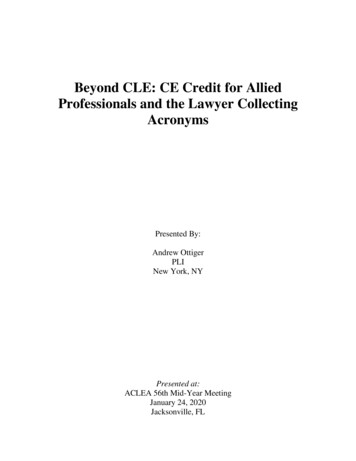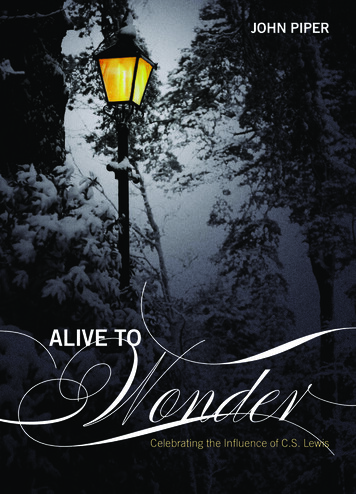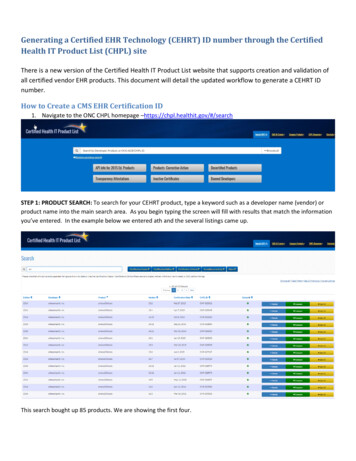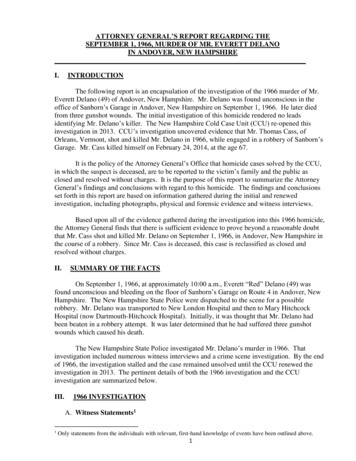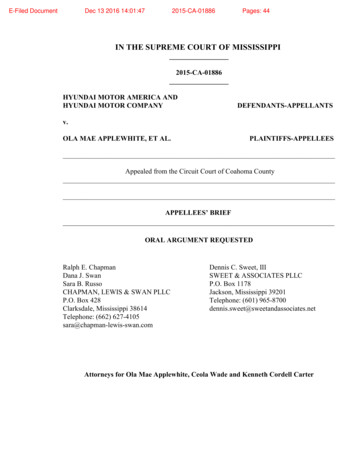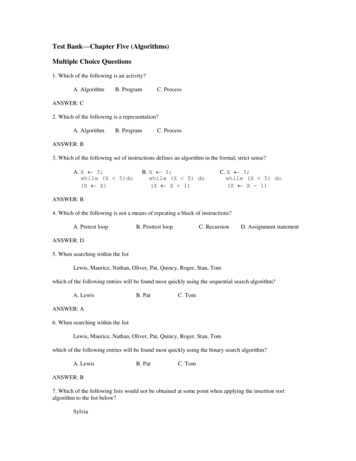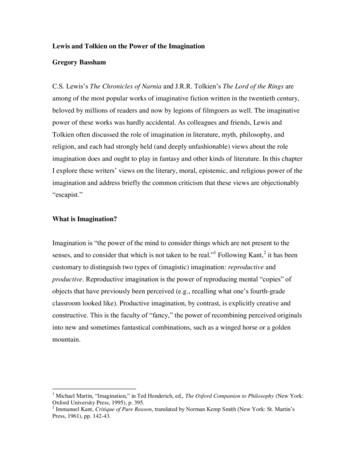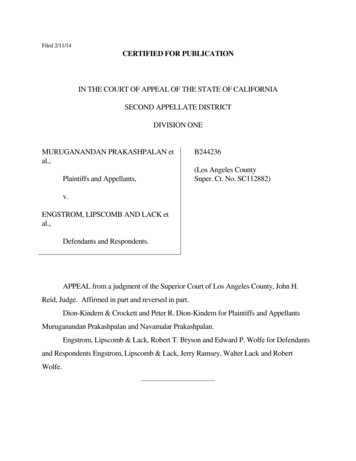
Transcription
Filed 2/11/14CERTIFIED FOR PUBLICATIONIN THE COURT OF APPEAL OF THE STATE OF CALIFORNIASECOND APPELLATE DISTRICTDIVISION ONEMURUGANANDAN PRAKASHPALAN etal.,B244236(Los Angeles CountySuper. Ct. No. SC112882)Plaintiffs and Appellants,v.ENGSTROM, LIPSCOMB AND LACK etal.,Defendants and Respondents.APPEAL from a judgment of the Superior Court of Los Angeles County, John H.Reid, Judge. Affirmed in part and reversed in part.Dion-Kindem & Crockett and Peter R. Dion-Kindem for Plaintiffs and AppellantsMuruganandan Prakashpalan and Navamalar Prakashpalan.Engstrom, Lipscomb & Lack, Robert T. Bryson and Edward P. Wolfe for Defendantsand Respondents Engstrom, Lipscomb & Lack, Jerry Ramsey, Walter Lack and RobertWolfe.——————————
Plaintiffs Muruganandan Prakashpalan and Navamalar Prakashpalan were clients ofdefendant law firm Engstrom, Lipscomb and Lack and the individual defendants Walter Lack,Jerry Ramsey, and Robert Wolfe, who are attorneys with the firm (collectively Engstrom).Plaintiffs appeal judgment entered after the trial court sustained Engstrom’s demurrer to theircomplaint based on Engstrom’s representation of plaintiffs. We affirm in part and reverse inpart.FACTUAL BACKGROUND AND PROCEDURAL HISTORY1.Factual Allegations of the Second Amended ComplaintPlaintiffs’ claims arise out of three separate representations undertaken by Engstrom:the Allegro Matter, the Malibu Construction Matter, and the Perlmutter Matter. The secondamended complaint (SAC) alleged 13 causes of action: (1) professional negligence/legalmalpractice/conflict of interest; (2) breach of fiduciary duty; (3) fraudulent concealment ofconflict of interest; (4) fraudulent concealment of embezzlement; (5) intentional fraud;(6) constructive fraud; (7) unjust enrichment; (8) unfair business practices (Allegro Matter);(9) unfair business practices (Perlmutter Matter); (10) conversion; (11) civil conspiracy tocommit intentional fraud; (12) civil conspiracy to commit conversion; and (13) accounting.Plaintiffs’ complaint alleged the following:(a)The Allegro MatterPlaintiffs’ home was severely damaged in the 1994 Northridge earthquake. FromJanuary 1995 to January 30, 1998, Engstrom and two other law firms represented plaintiffsand other property owners in a bad faith and property damage claim against their insurer, StateFarm. The action was not a class action, and plaintiffs were specifically assigned toEngstrom. In or around November 1997, Engstrom entered into a settlement with State Farmand obtained over 100 million for 93 insured families. Plaintiffs allege that Engstromreceived 245,000, about one-third of plaintiffs’ settlement share, and distributed theremaining 500,000 to plaintiffs. In February 2012, plaintiffs were able to randomly contact17 of the plaintiffs in the Allegro Matter. Based on their discussions with the Allegroplaintiffs, it was clear to plaintiffs that Engstrom had instructed all plaintiffs in the Allegro2
Matter not to discuss the settlement funds with anyone. However, plaintiffs concluded, afterconducting a mathematical analysis of the settlement and of the overall litigation, that therewas over 22 million of settlement funds unaccounted for. Based upon this discrepancy,plaintiffs calculated that Engstrom had withheld funds from plaintiffs’ share of the settlementfunds.(b)The Malibu Construction MatterFrom January 1995 through January 30, 1998, Engstrom represented plaintiffs inconnection with the Malibu Construction Matter. In late 1994, plaintiffs purchased land inMalibu, California, a fact which Engstrom knew. In early 1995, due to a contractor’snegligence, the Malibu property sustained “hill cut failure.” Engstrom providedrepresentation to plaintiffs in connection with the contractor’s negligence, plaintiffs’ insuranceclaim against its insurer, State Farm, and other construction matters. State Farm provided adefense to plaintiffs in connection with the hill cut failure; this defense was provided at thesame time as the Allegro Matter was being litigated. As a result, Engstrom requested thatplaintiffs permit Engstrom to review all of plaintiffs’ documents and discovery responsesprior to submission to State Farm.Engstrom requested that plaintiffs estimate the cost to repair the hill cut failure,including the cost of importing dirt. Plaintiffs had learned they could obtain free dirt from theLos Angeles County Public Works Department (Public Works), and Engstrom knew ofplaintiffs’ plans to import dirt to repair the hill cut failure. Plaintiffs requested that Engstromkeep this information confidential.During the Malibu Construction Matter, Engstrom provided legal advice regardingplaintiffs’ neighbors the Perlmutters in connection with a nuisance, and also assisted in gettinga restraining order against Jacob Perlmutter, who allegedly hired thugs to harass plaintiffNavamalar Prakashpalan.(c)The Perlmutter MatterIn January 2005, plaintiffs’ Malibu property sustained damages due to a landslideoriginating on the Perlmutters’ property. In 2006, plaintiffs learned the Perlmutters were3
involved in unpermitted construction activity and illegal construction that caused thelandslide, including abandonment of their 25 feet deep septic pits. Plaintiffs filed a complaintagainst the Perlmutters for negligence arising from the landslide, and the Perlmutters filed across-complaint against plaintiffs alleging that plaintiffs’ Malibu construction was the causeof the landslide. The Perlmutters’ insurer hired the Law Office of Paul Wright to representthem in this matter.In early 2009, allegedly after discovering their case had no merit, the Perlmuttersretained Engstrom on a contingency basis as their additional attorneys. Although they knewthe Perlmutter Matter was substantially related to the Malibu Construction Matter, Engstromdid not notify plaintiffs of the representation or obtain their consent, and Engstrom knew thatthe Perlmutters were claiming that plaintiffs’ slope repair was the cause of the landslide. YetEngstrom failed to disclose the conflict of interest and during the litigation, Engstrom andtheir expert claimed that the 3,800 cubic yards of dirt plaintiffs imported caused the landslide.Engstrom used attorneys who did not have direct communication with plaintiffs in the MalibuConstruction Matter and Allegro Matter, all of which was a clever plan to conceal the conflictof interest from plaintiffs.Sometime after the Perlmutters retained Engstrom, the Perlmutters’ insurancecompany hired the law firm of Gibbs, Giden, Locher, Turner & Senet (Gibbs) to join asadditional attorneys to represent the Perlmutters in settling the Perlmutter Matter. During thePerlmutter Matter, the Perlmutters revealed that their unpermitted construction activities wereperformed by entities collectively known as “the McDermott contractors.” Plaintiffs amendedtheir complaint to add the McDermott contractors as defendants, including McDermottPlumbing (represented by Skapik Law Group) and McDermott Pumping (represented byWalters, McClusky & Boehle).After pretrial discovery, Gibbs wanted to settle the matter on behalf of the Perlmutterswith plaintiffs, and the Perlmutters made a Code of Civil Procedure section 998 offer.Plaintiffs declined the offer. Gibbs requested continuance of the trial to settle with plaintiffs,and the court granted a continuance to permit mediation. At a mediation held December 3,4
2010, defendant Wolfe revealed the damaging information that plaintiffs intended to importdirt from Public Works. The next day, plaintiffs realized the significance of Wolfe’srevelation to their case. Plaintiffs “caved in” and accepted the Code of Civil Proceduresection 998 offer, although plaintiffs’ loss was over 4 million and the offer was 500,000.When the McDermott contractor entities—who were motivated to settle because theirnegligence caused the landslide—learned of the settlement, plaintiffs were likewise forced tosettle with the McDermott parties for 500,000.Plaintiffs allege they did not discover the conflict of interest until April 2011 while incourt on the Perlmutter Matter. At that time, plaintiffs observed a familiar face in thecourtroom gallery among the spectators, and recognized the individual as defendant attorneyRamsey. In early May, plaintiffs wrote to Engstrom regarding the conflict of interest, and onMay 3, 2011, received a letter in response from Engstrom in which Engstrom denied anyconflict of interest, stated that plaintiffs waived the conflict, any contact with plaintiffs’adversaries was insignificant and minimal, and the two matters were not substantially related.Plaintiffs further allege that “[o]n May 16, 2011, [Engstrom] emailed [their] attorneythreatening [them] with a debtor examination to effectuate a lien on PLAINTIFFS’ propertyand thereby [Engstrom] collected over 1.3 million.” Elsewhere in the SAC, plaintiffs allegethe 1.3 million constituted the judgment against them in the Perlmutter Matter.2.Procedural BackgroundOn June 6, 2011, plaintiffs commenced this lawsuit, alleging six causes of action forprofessional negligence and malpractice; breach of fiduciary duty and conflict of interest;fraudulent concealment; constructive fraud, fiduciary fraud, intentional fraud and conspiracyto commit fraud; unjust enrichment; and unfair business practices under Business &Professions Code section 17500 (UCL). Plaintiffs filed a first amended complaint onJanuary 17, 2012, alleging eight causes of action (the same six as the original complaint plusclaims for conversion and civil conspiracy).On April 12, 2012, the trial court overruled defendant’s demurrer to the first cause ofaction and sustained the demurrer as to the second, third, fourth, fifth, sixth, seventh, and5
eighth causes of action of the first amended complaint, with leave to amend. Plaintiffs filedtheir SAC on April 30, 2012.Engstrom demurred to the SAC, arguing the alleged confidential information about thesource of the dirt used in the Malibu Construction Matter was a matter of public record andtherefore not confidential; Engstrom was entitled to dismissal of the Allegro Matter claimsbecause it could not mount an adequate defense without breaching the attorney-clientprivilege with respect to the other Allegro Matter plaintiffs under Solin v. O’Melveny & Myers(2001) 89 Cal.App.4th 451 (Solin); plaintiffs did not plead fraud with sufficient particularity;plaintiffs could not seek restitution because their claims were made under an enforceablecontract; plaintiffs failed to allege recoverable damages under the UCL; plaintiffs’ conversionclaim failed to allege an identifiable sum of money; plaintiffs failed to allege all elements of acivil conspiracy; plaintiffs failed to state facts sufficient to state a claim for accounting; andcertain of plaintiffs’ claims relating to the Allegro Matter (the second, fourth, seventh, eighth,tenth causes of action) were time-barred. Engstrom requested judicial notice of the gradingpermit plaintiffs obtained from the City of Malibu in 1998 connection with installation of a“manufactured fill slope” and the Permit issued to the County of Los Angeles for the purposeof entering the plaintiffs’ property to deposit fill material.Engstrom also moved to strike certain portions of plaintiffs’ SAC that requestedpunitive damages and attorney fees and costs on the grounds that the SAC failed to allegemalice, fraud or oppression and the cause of action for accounting did not permit the recoveryof damages, and the UCL did not provide for attorney fees.In opposition,1 plaintiffs generally contended the Public Works documents wereexpired permits and had been obtained as a result of a privileged communication withPlaintiffs attached to their opposition defendants’ answers to interrogatories inwhich defendants stated that the settlement in the Allegro Matter was subject to aconfidentiality agreement. Plaintiffs also sought judicial notice of (1) a copy of the asbuilt approved plan from the City of Malibu with respect to the grading,(2) correspondence from the City of Malibu regarding the grading dated November 23,2010 stating that no imported soils were used in the grading, and (3) defendant Wolfe’s16
plaintiffs. Further, plaintiffs argued the documents were not public records because PublicWorks does not provide information over the phone or over the counter unless a party isaware of the information and makes a request in writing. Plaintiffs further distinguished thecase from Solin, supra, 89 Cal.App.4th 451, in which the clients intervened in a case toprevent disclosure of confidential information; here, the other parties in the Allegro Matterwere coming forward and volunteering information, and thus the evidence was available.Further, the statute of limitations was not a bar to plaintiffs’ claims because Engstrom’sactions were committed in secret.Plaintiffs also opposed the motion to strike, contending the fraud alleged was sufficientunder Civil Code section 3294, pointing to Engstrom’s alleged conduct in representingadverse interests without disclosing same to plaintiffs and in disclosing confidentialinformation, and by taking settlement funds to which they were not entitled.In reply, Engstrom asserted that plaintiffs’ failure to plead facts sufficient to entitlethem to equitable tolling of the statute of limitations under the discovery rule in the AllegroMatter because there was nothing preventing plaintiffs from discovering any allegedmisconduct in the 15 years since the settlement of the Allegro Matter. Further, unless all theAllegro plaintiffs waived the attorney-client privilege, plaintiffs would not be able todemonstrate how the settlement monies were disbursed. With respect to the Public Worksdocument, Engstrom contended plaintiffs shared this allegedly confidential information with apublic entity long before Engstrom allegedly improperly informed their adversaries.The court granted Engstrom’s request for judicial notice and granted plaintiffs’ requestfor judicial notice only as to the final approved plan from the City of Malibu.The court sustained the demurrer without leave to amend. The court found that withrespect to those claims based on the Allegro Matter (second, fourth, seventh, eighth, tenth,twelfth and thirteenth causes of action), the statute of limitations did not bar those claims evenunder the delayed discovery rule because plaintiffs alleged sufficient facts to show they didcorrespondence dated December 3, 2010 with Public Works requesting documentsevidencing the placing of fill dirt at plaintiffs’ residence.7
not discover their claim until November 2011.2 However, plaintiffs’ claims based on theAllegro Matter settlement were barred under Solin, supra, 89 Cal.App.4th 451, which heldthat where a lawsuit is incapable of complete resolution without breaching the attorney-clientprivilege, the suit may not proceed, if a balancing of certain factors set forth in Solin andexplained in Dietz v. Meisenheimer Herron (2009) 177 Cal.App.4th 771 is satisfied. Here, thetrial court found the plaintiffs had failed to satisfy those factors because although some of theAllegro plaintiffs had come forward, Engstrom would be forced to reveal confidentialinformation relating to the other Allegro plaintiffs in order to defend the action, and thusdemurrer was sustained as to those claims on that basis. Further, plaintiffs’ claims that aportion of the Allegro Matter settlement proceeds were unaccounted for was entirely based onspeculation.With respect to claims based on the Perlmutter Matter (first, third, fifth, sixth, ninth,and eleventh causes of action), the trial court found that although Engstrom’s judiciallynoticed documents did not establish plaintiffs’ importation of fill dirt was a matter of publicrecord, plaintiffs nonetheless failed to explain how they were damaged by this disclosure.The court also addressed the specific merits of certain of plaintiffs’ claims, as morefully discussed below.The trial court denied leave to amend because plaintiffs failed to show how they couldcorrect the deficiencies in their complaint. In addition, because plaintiffs failed to plead anyviable causes of action to support punitive damages, the trial court granted the motion tostrike.DISCUSSIONI.Standard of Review“The function of a demurrer is to test the sufficiency of a pleading as a matter of law,[and] we apply the de novo standard of review in an appeal following the sustaining of a2Although plaintiffs alleged in their SAC that they became aware of their claim inFebruary 2012, plaintiffs initially propounded discovery regarding the Allegro Matter inNovember 2011.8
demurrer without leave to amend.” (California Logistics, Inc. v. State of California (2008)161 Cal.App.4th 242, 247; Holiday Matinee, Inc. v. Rambus, Inc. (2004) 118 Cal.App.4th1413, 1420.) A complaint “is sufficient if it alleges ultimate rather than evidentiary facts,” butthe plaintiff must set forth the essential facts of his or her case “‘“‘with reasonable precisionand with particularity sufficient to acquaint [the] defendant with the nature, source, andextent’”’” of the plaintiff’s claim. Legal conclusions are insufficient. (Doe v. City of LosAngeles (2007) 42 Cal.4th 531, 550 & 551, fn. 5.) “We assume the truth of the allegations inthe complaint, but do not assume the truth of contentions, deductions, or conclusions of law.”The trial court errs in sustaining a demurrer “if the plaintiff has stated a cause of action underany possible legal theory, and it is an abuse of discretion for the court to sustain a demurrerwithout leave to amend if the plaintiff has shown there is a reasonable possibility a defect canbe cured by amendment.” (California Logistics, Inc. v. State of California, supra, 161Cal.App.4th at p. 247.)A complaint must contain a “statement of the facts constituting the cause of action, inordinary and concise language.” (Code Civ. Proc., § 425.10, subd. (a)(1).)3 The facts to bepleaded are those upon which liability depends—facts constituting the cause of action, or“ultimate facts.” (Doe v. City of Los Angeles, supra, 42 Cal.4th at p. 550.) Such facts must beplausible. (See Id. at p. 551.) “A complaint must allege the ultimate facts necessary to thestatement of an actionable claim. It is both improper and insufficient for a plaintiff to simplyplead the evidence by which he hopes to prove such ultimate facts.” (Careau & Co. v.Security Pacific Business Credit, Inc. (1990) 222 Cal.App.3d 1371, 1390.) In negligencecases, although negligence may be pleaded in general terms, if the pleaded facts of negligenceand injury do not naturally give rise to an inference of causation, plaintiff must plead specificfacts explaining how the conduct caused or contributed to plaintiff’s injury. (Bockrath v.Aldrich Chemical Co. (1999) 21 Cal.4th 71, 78.)3All statutory references herein are to the Code of Civil Procedure unlessotherwise indicated.9
II.Engstrom’s DemurrerA.Plaintiffs’ Claims Based on the Allegro Action—Statute of LimitationsNotwithstanding the trial court’s ruling that plaintiffs’ claims based on the AllegroMatter were not barred by the statute of limitations, Engstrom’s brief argues that the statute oflimitations bars such claims. As a general rule, respondents who fail to file a cross-appealcannot claim error in connection with the opposing party’s appeal. (Estate of Powell (2000)83 Cal.App.4th 1434, 1439.) A limited exception to this rule is provided by section 906,which states in pertinent part: “The respondent . . . may, without appealing from [the]judgment, request the reviewing court to and it may review any of the foregoing [describedorders or rulings] for the purpose of determining whether or not the appellant was prejudicedby the error or errors upon which he relies for reversal or modification of the judgment fromwhich the appeal is taken.” “‘The purpose of the statutory exception is to allow a respondentto assert a legal theory which may result in affirman
During the Malibu Construction Matter, Engstrom provided legal advice regarding . including McDermott Plumbing (represented by Skapik Law Group) and McDermott Pumping (represented by Walters,
